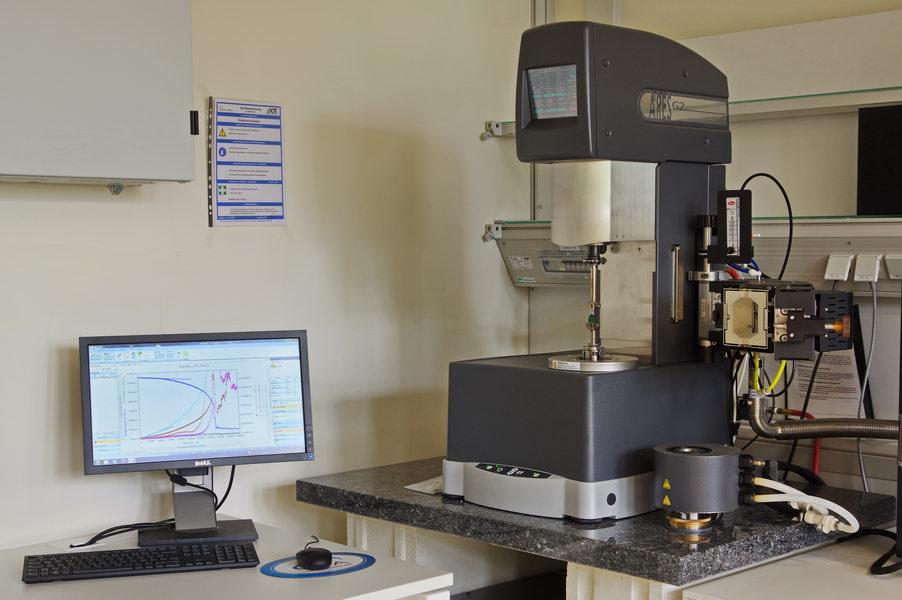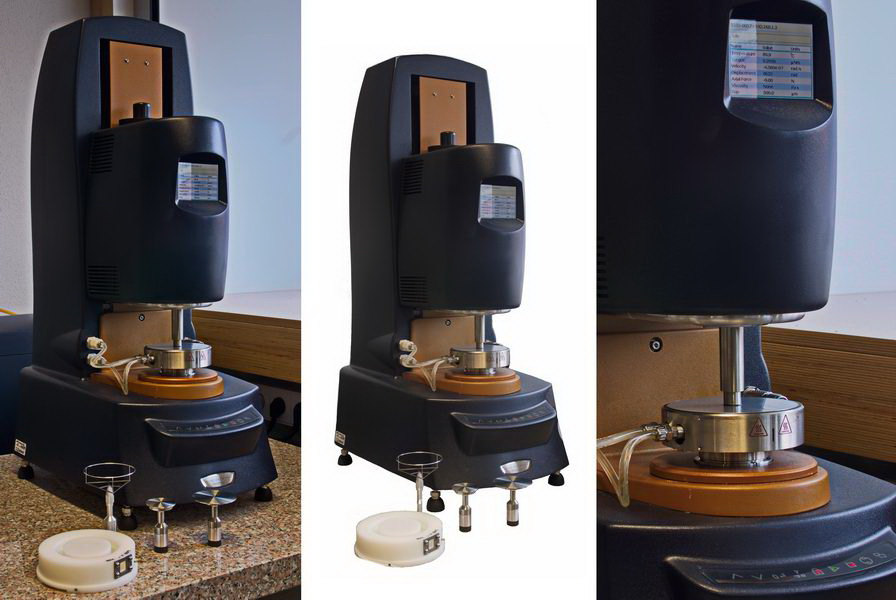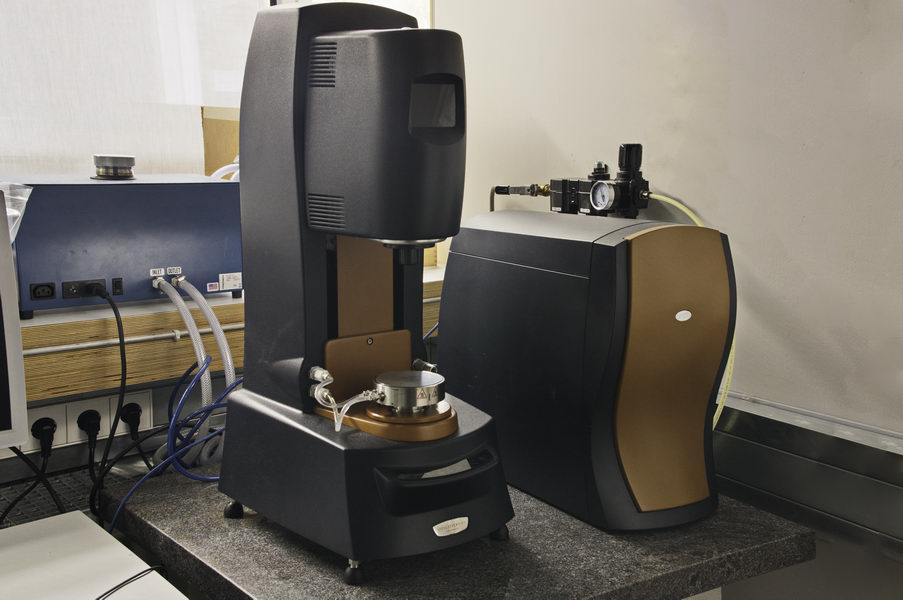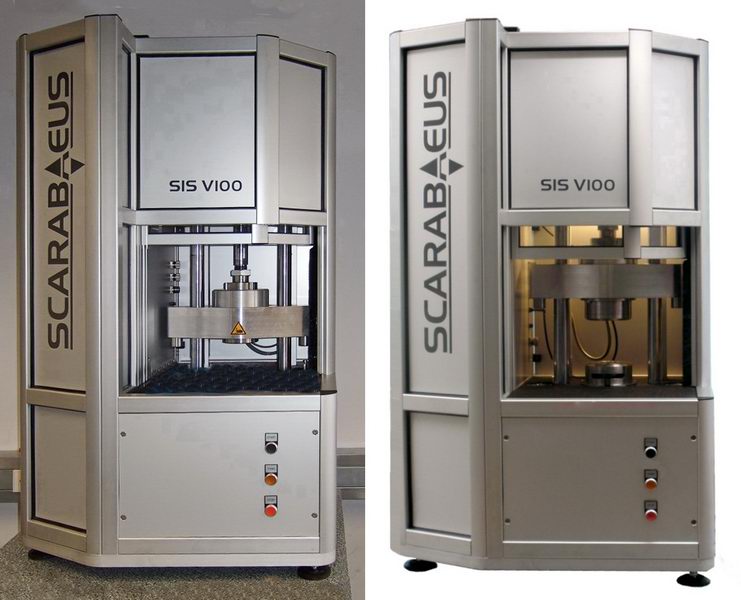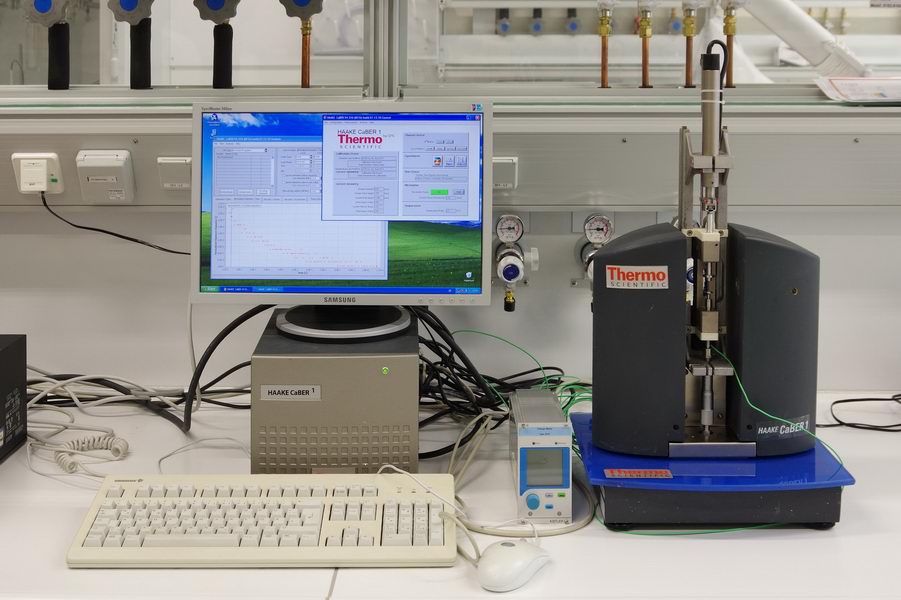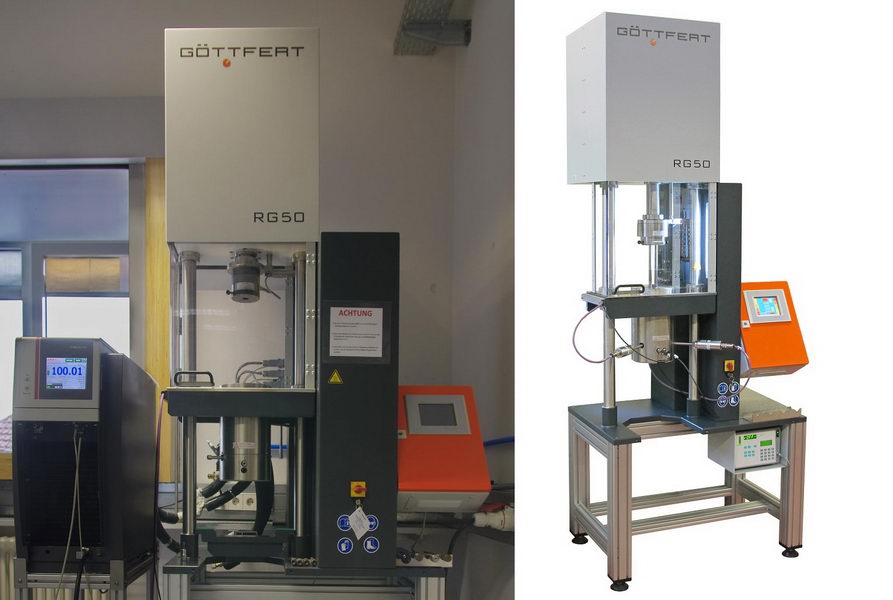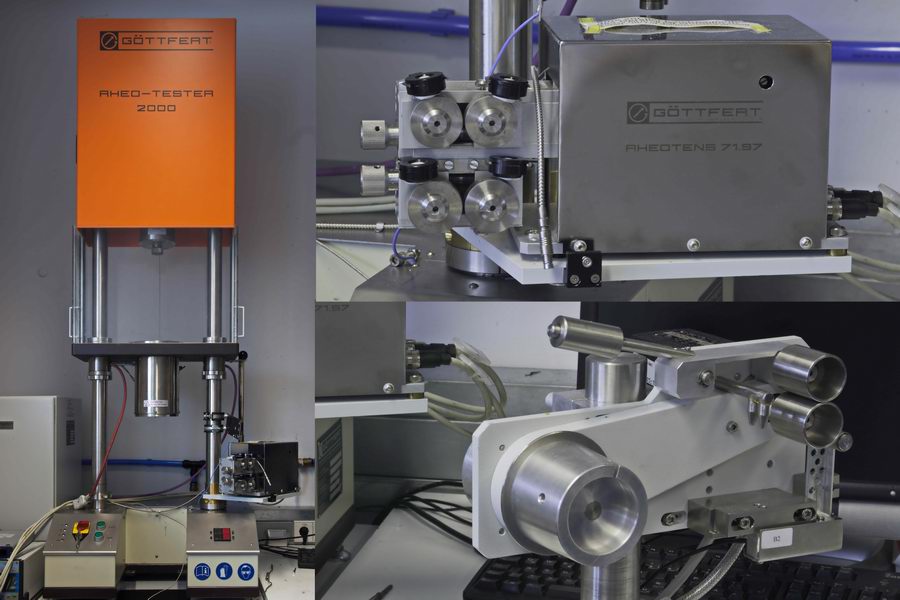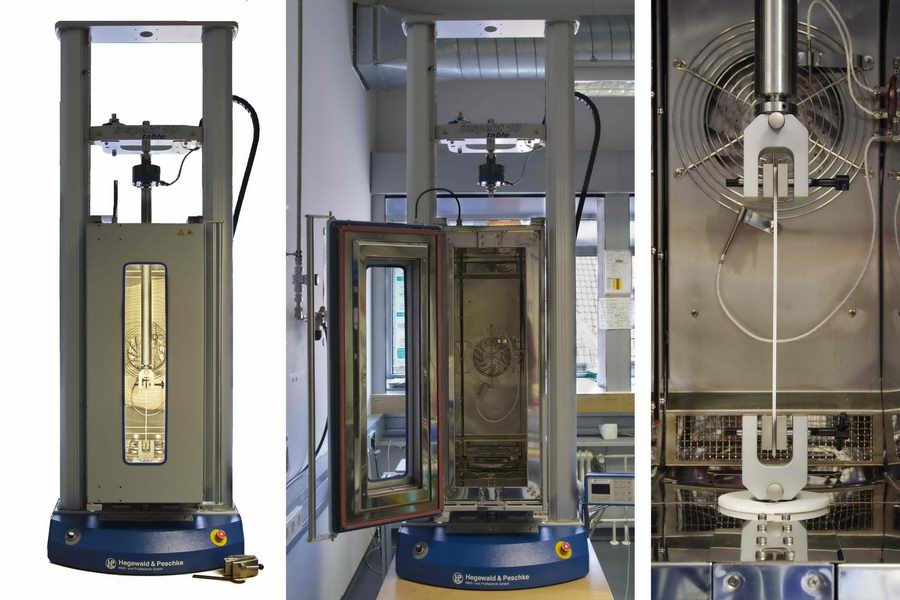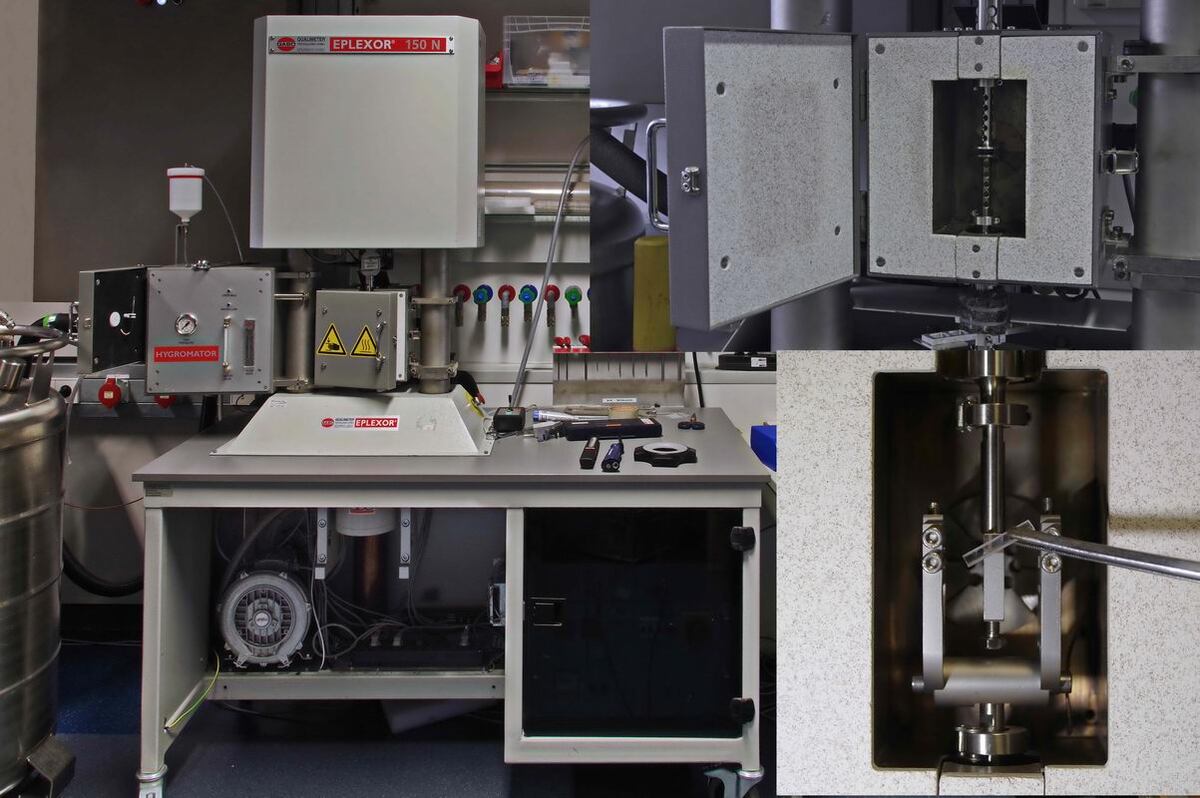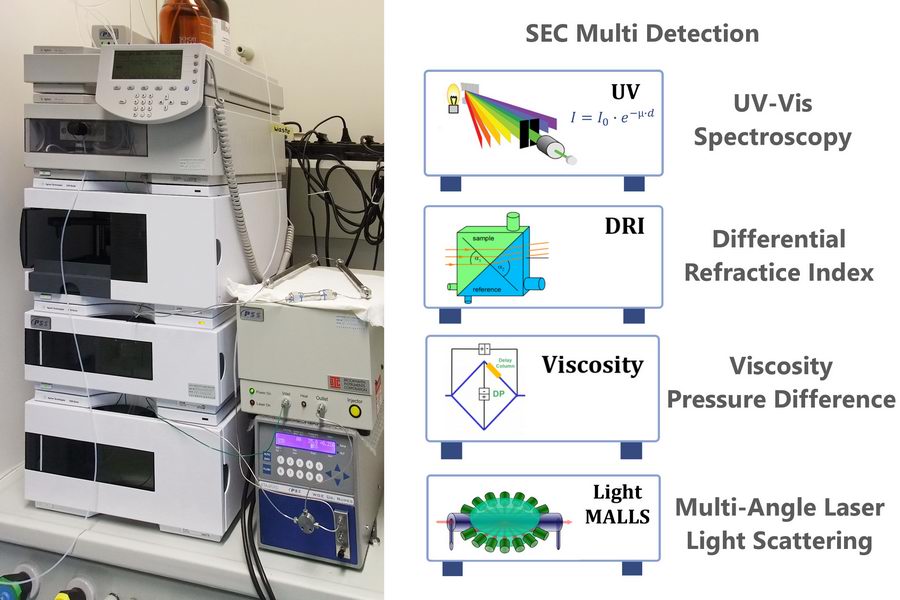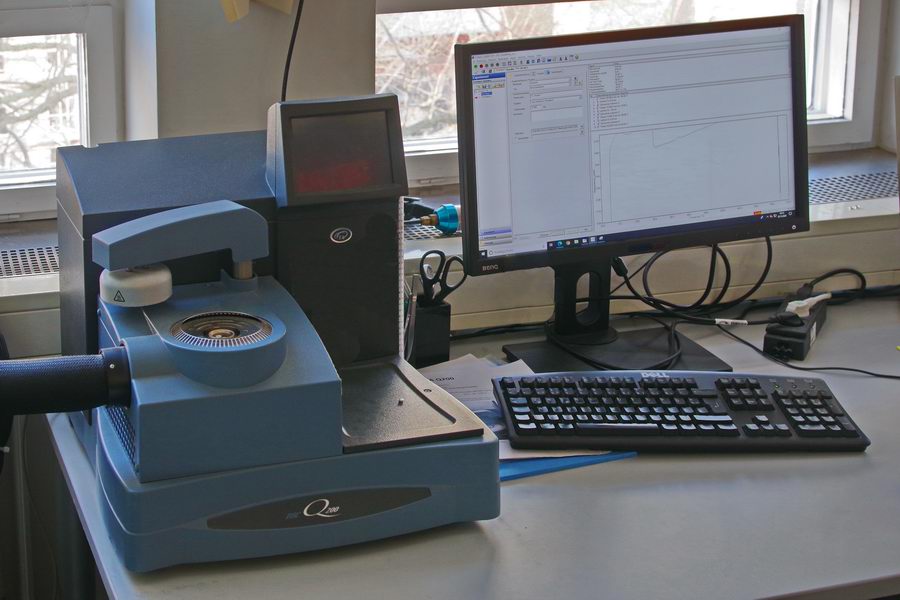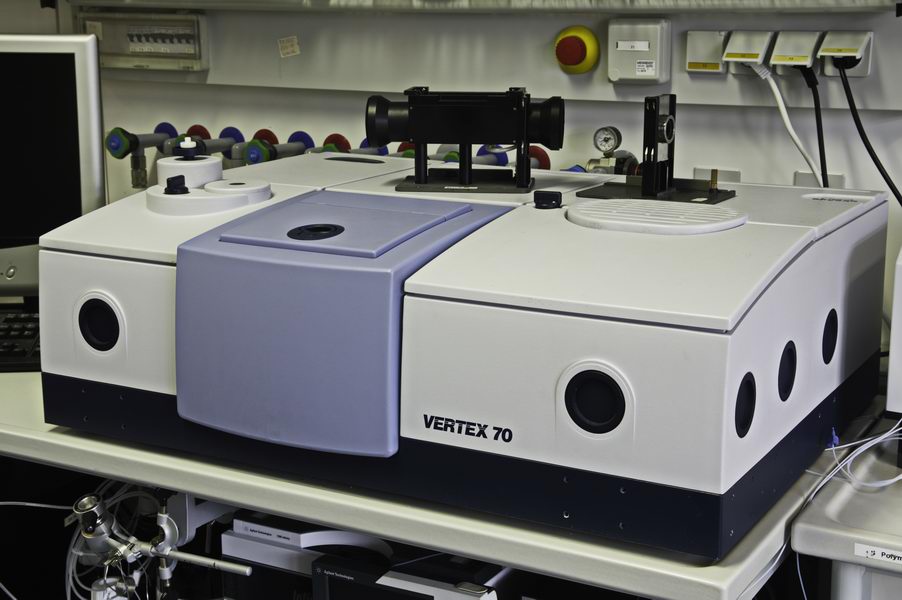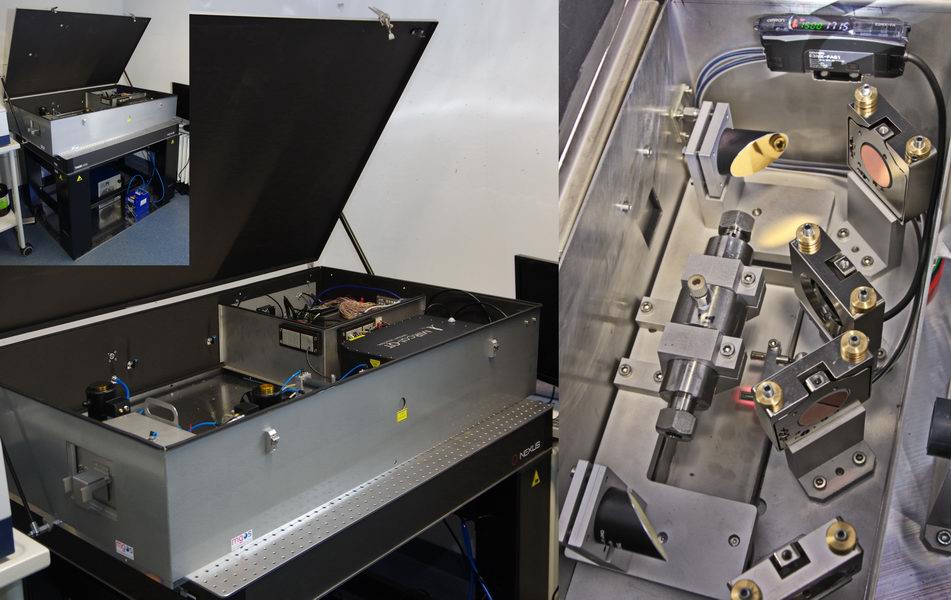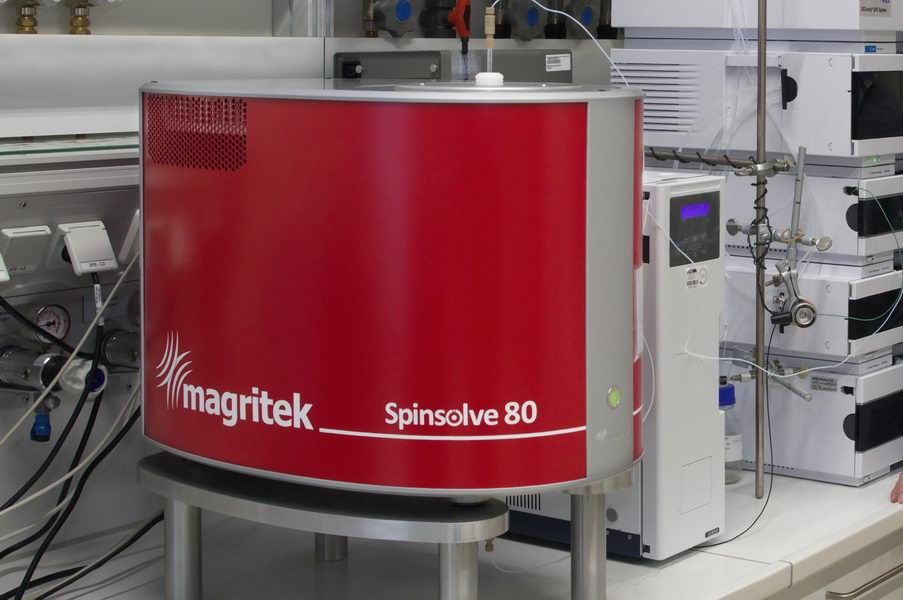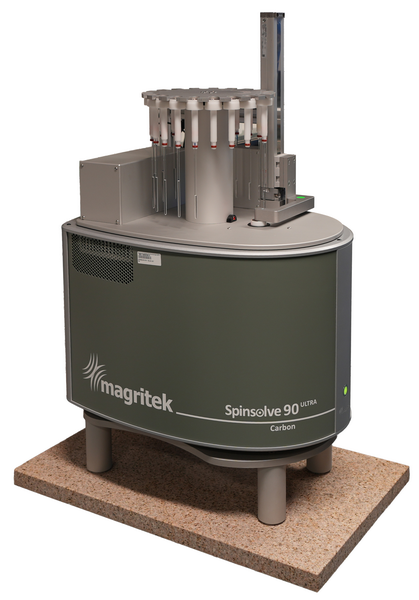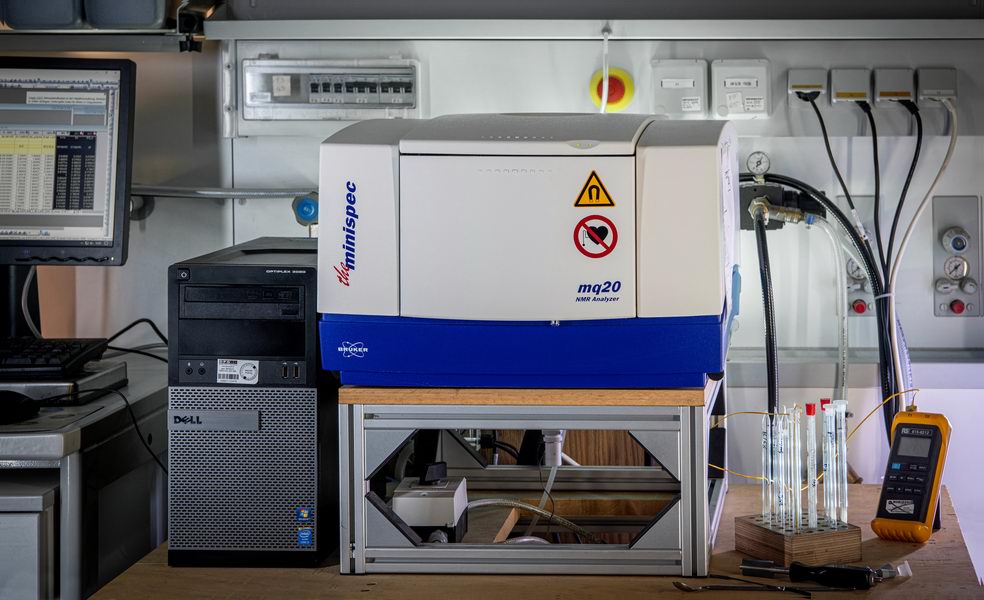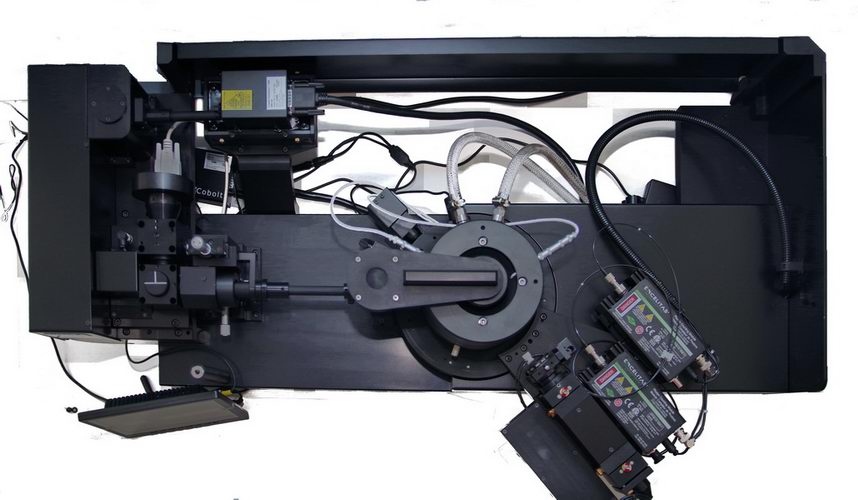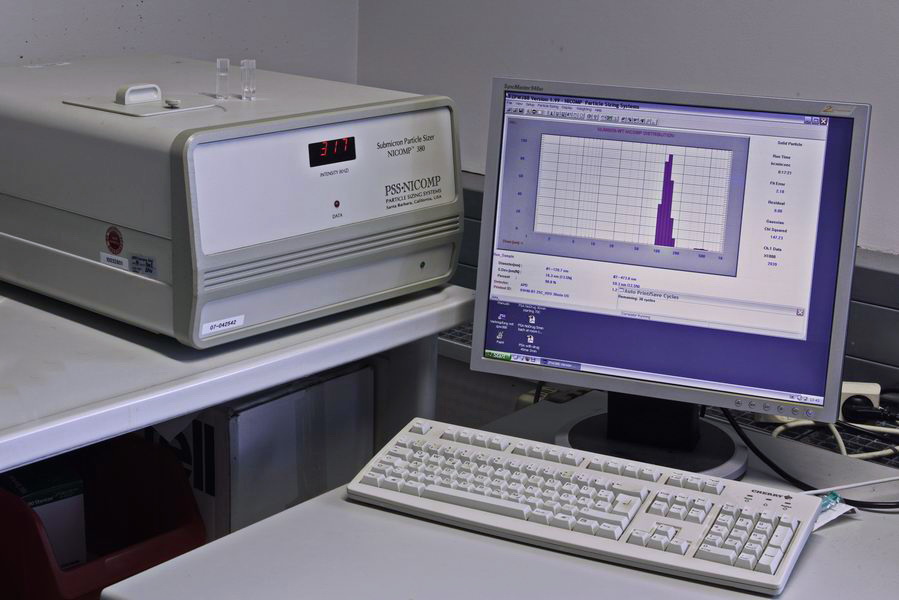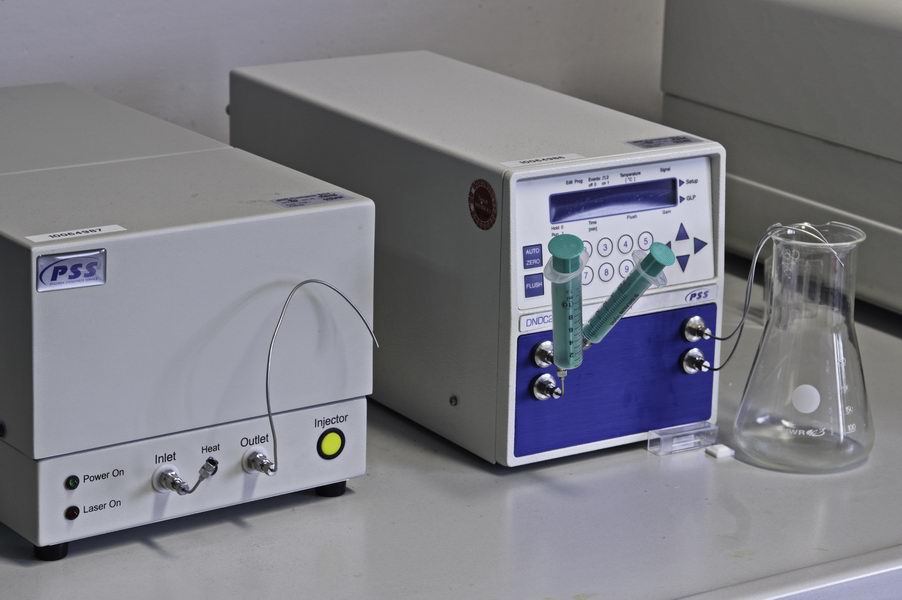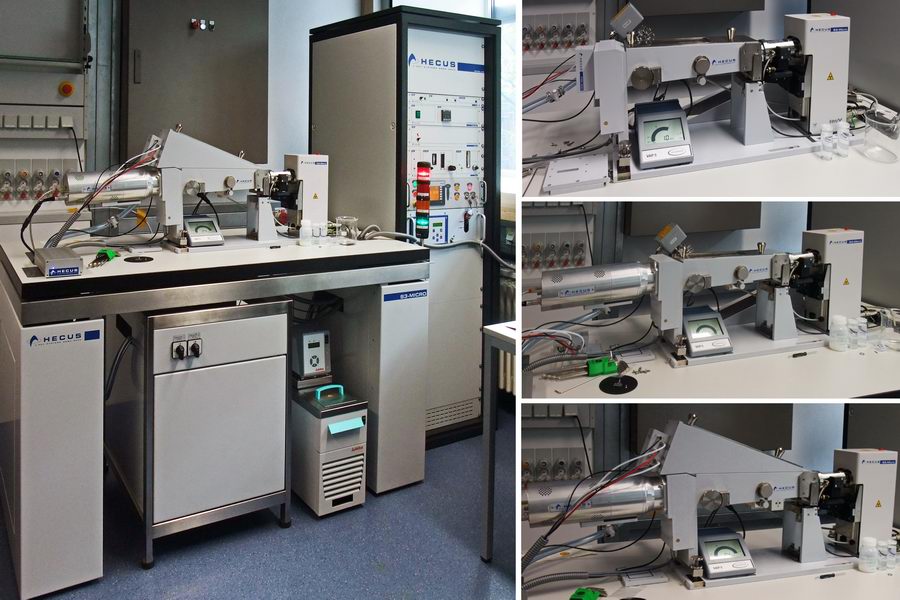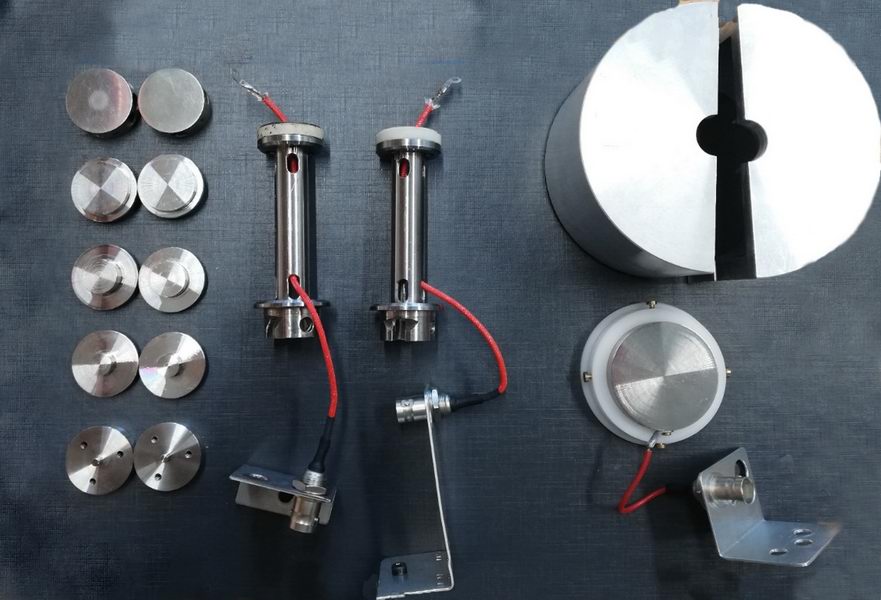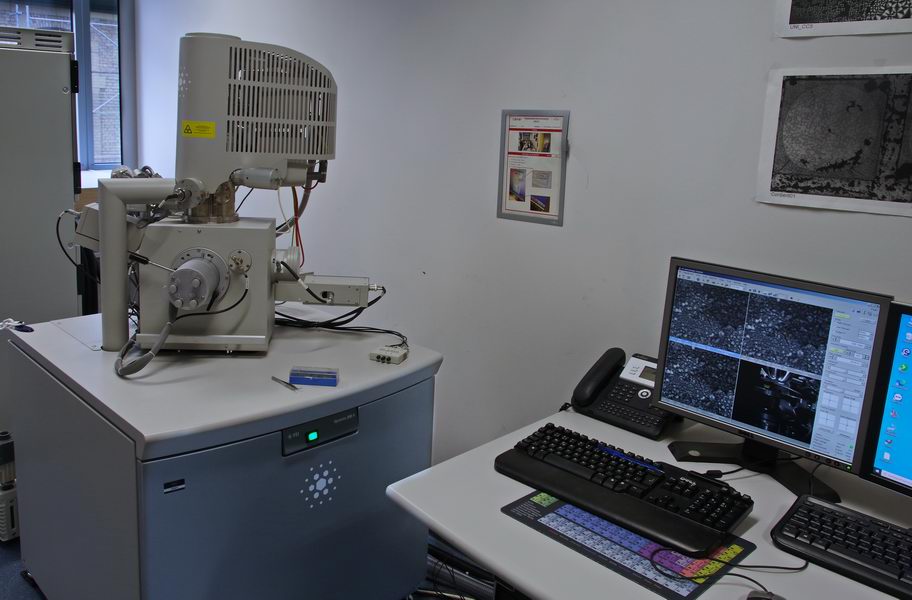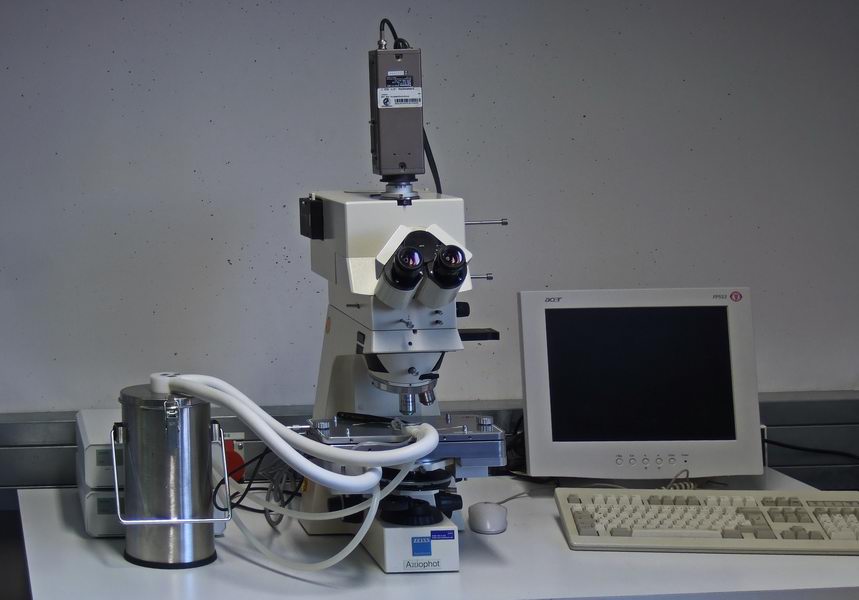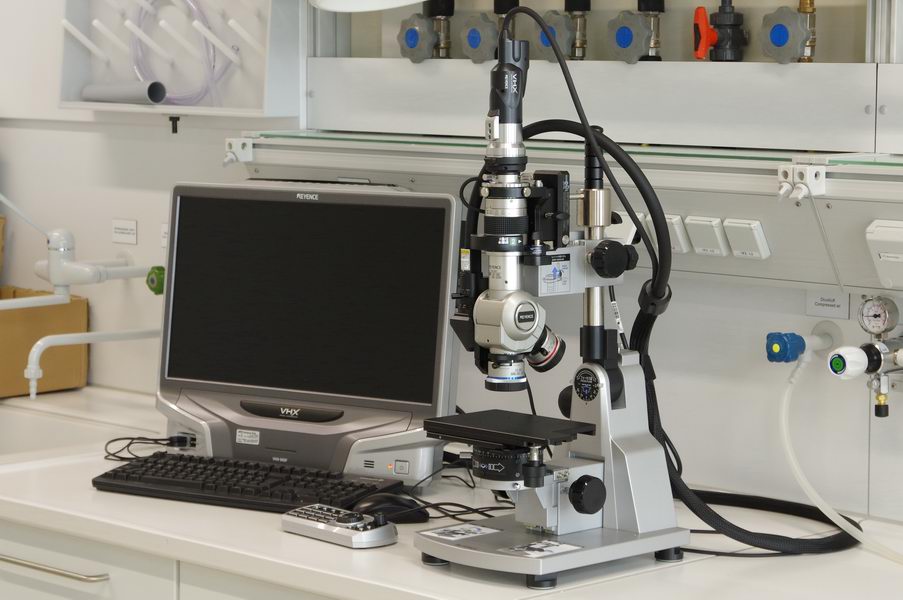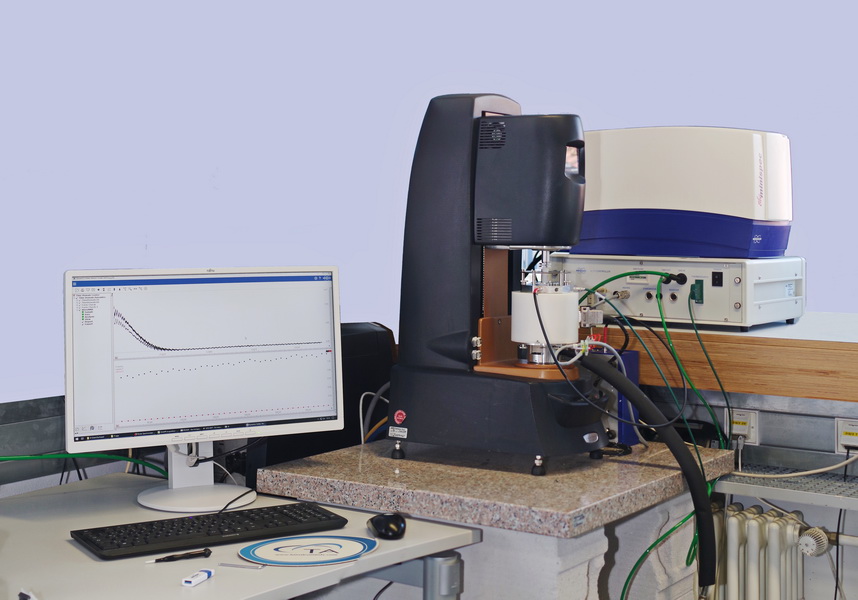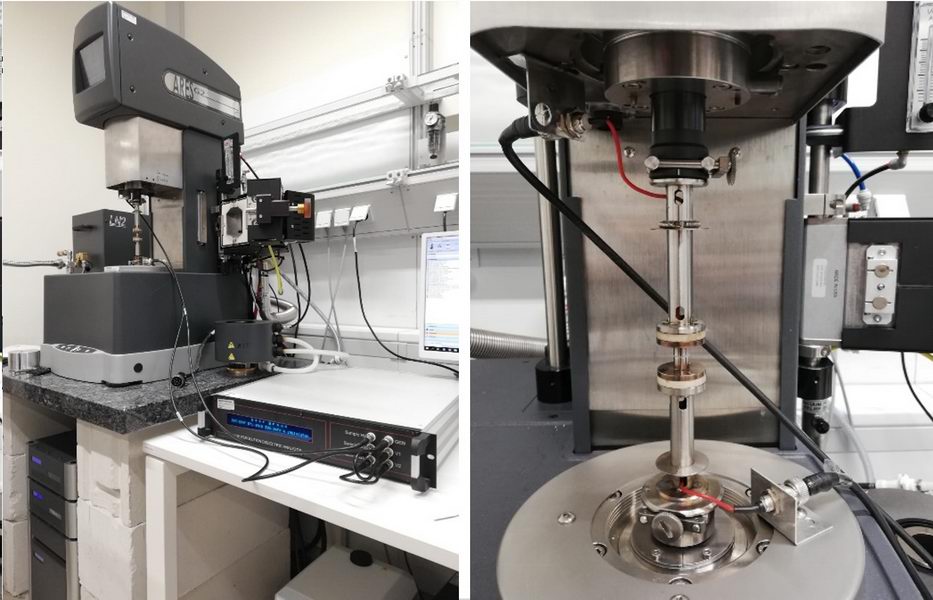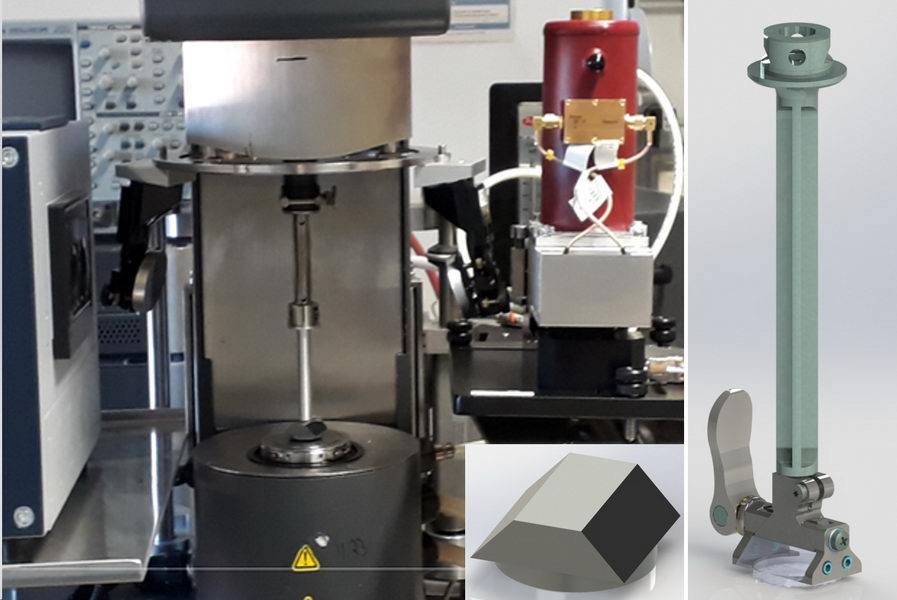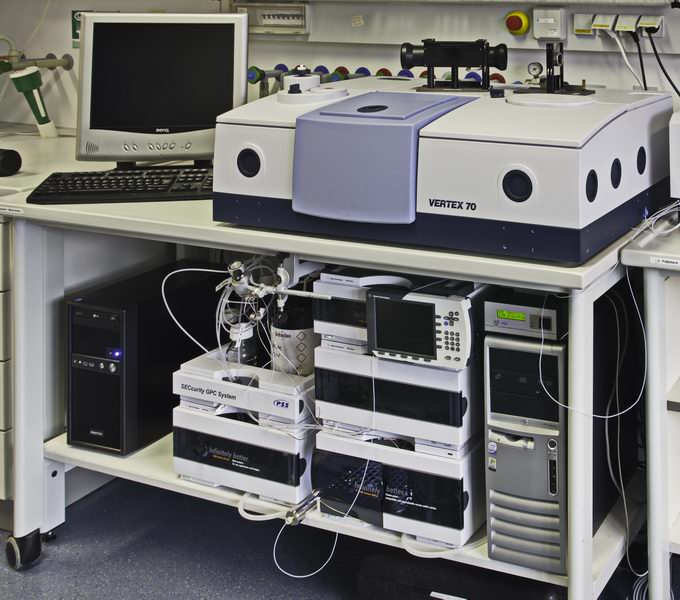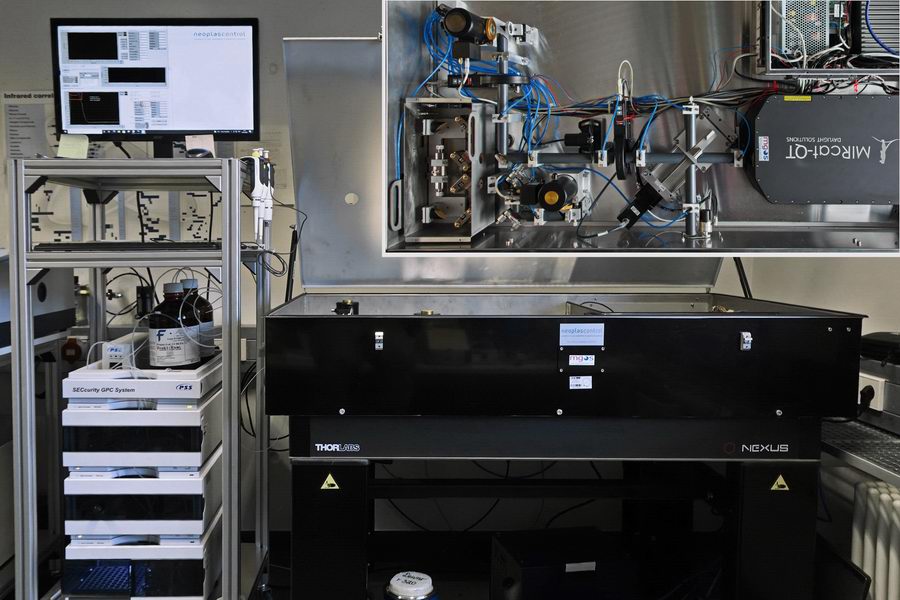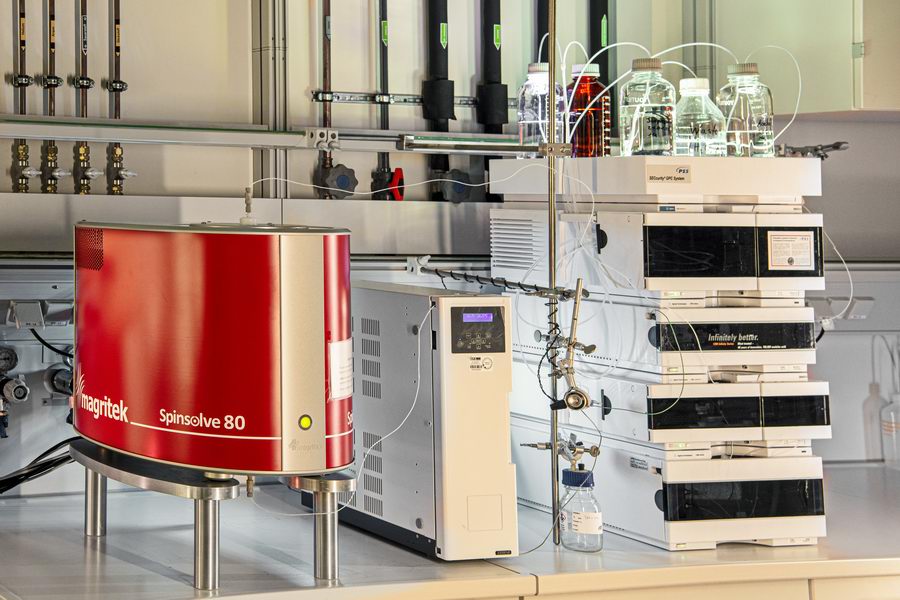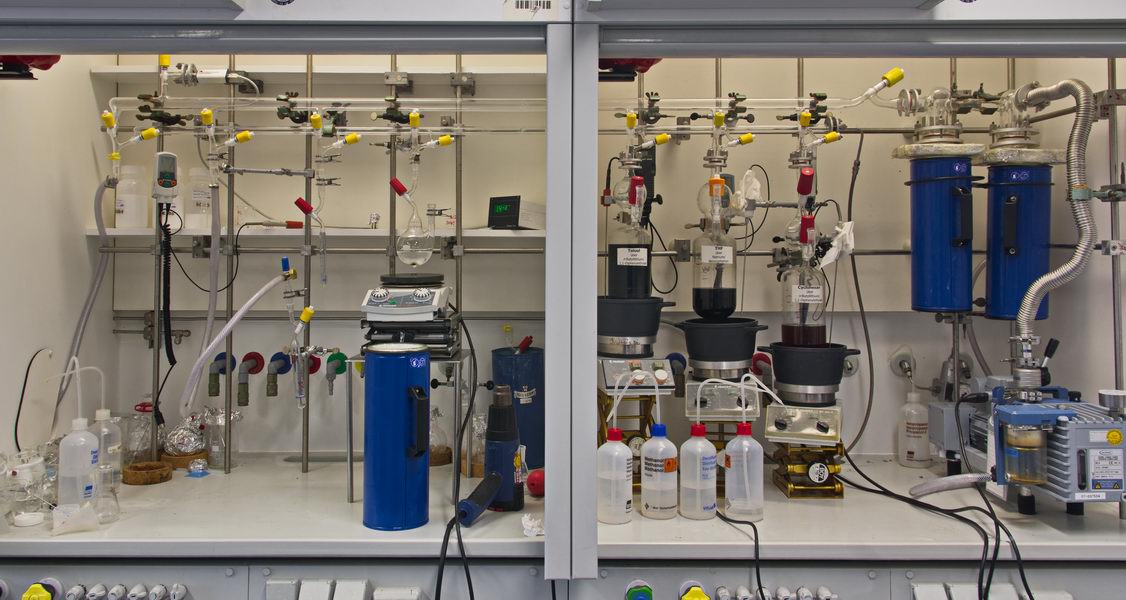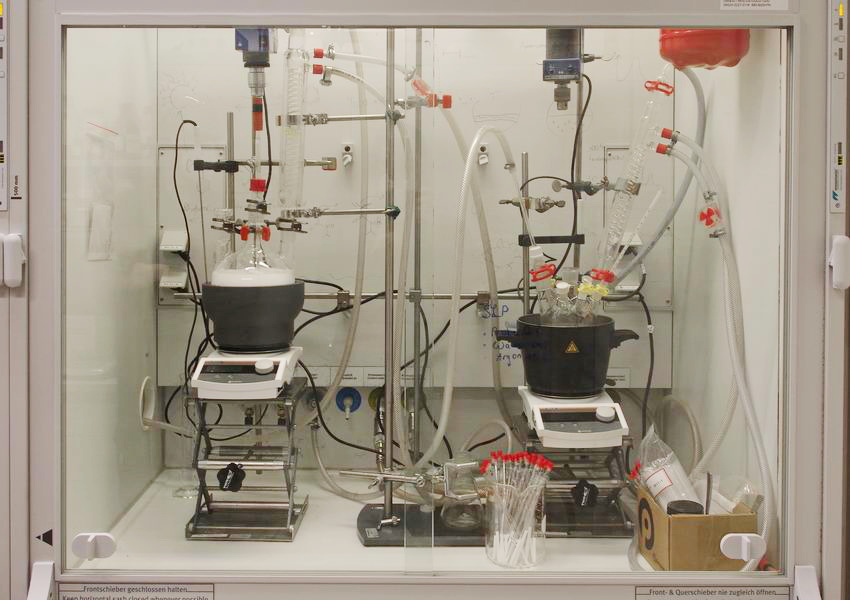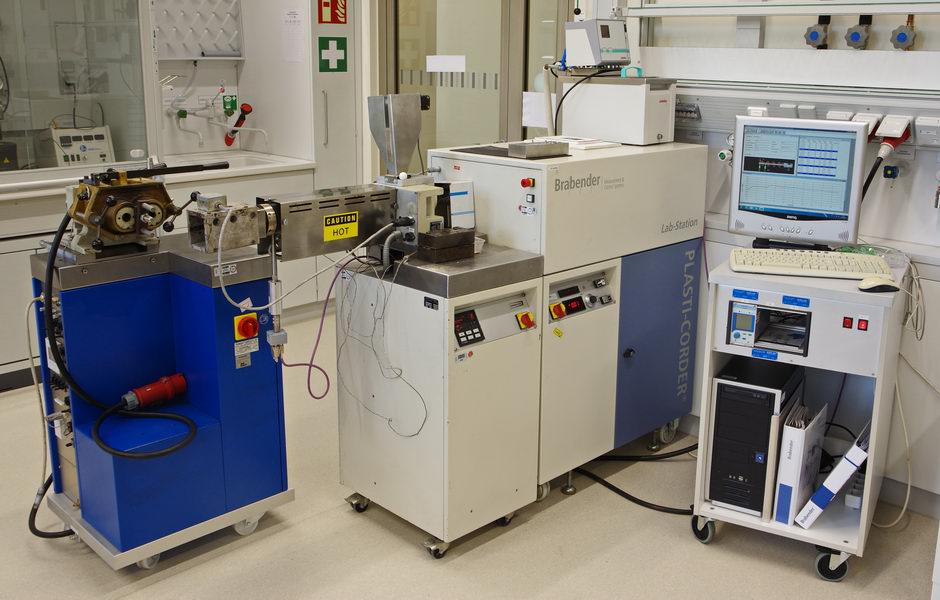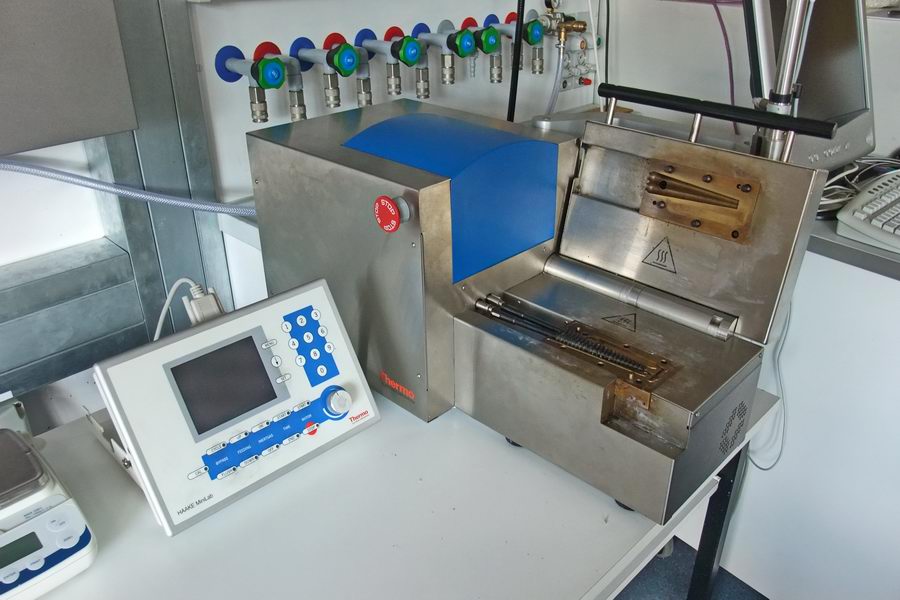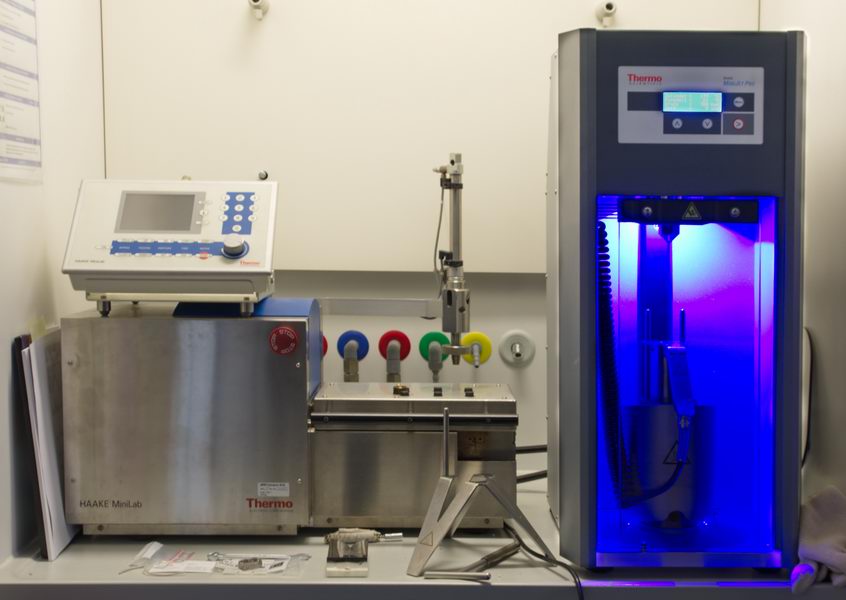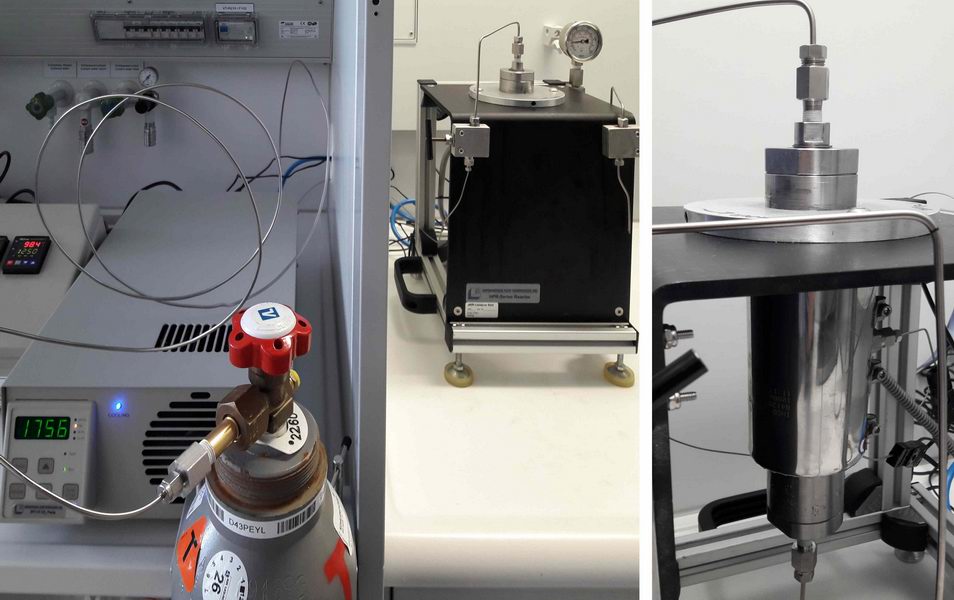Hier finden Sie eine vollständige Aufstellung der Charakterisierungsmethoden mit Kurzinformationen (in English) und Ansprechpartner, sortiert nach Bereichen.
| Rheologische & Mechanische Charakterisierung |
|---|
| Polymer Charakterisierung |
| Kombinierte Methoden |
| Synthese |
| Polymerverarbeitung |
Shear Rheometer (high sensitivity, strain controlled)
ARES-G2, TA-Instruments
Contact Person: Daniel Zimmermann
ARES rheometer of the latest generation with broad sensitivity range starting from Low viscosity (Water bath) up to polymer melts. The group is owning two devices of this instrument. Including Oven for temperature range from -70 °C to 400 °C). Linear and non-linear regime (FT-Rheology) of material behaviour, FT-Rheology included in standard software.
A wide variety of sample geometries are available, ranging from plate-plate and cone-plate geometries, also special devices for strain rheology and torsion measurements, vane geometry, Couette geometry and various self-developed geometries, e.g. for dielectric spectroscopy.
Shear Rheometer with highest sensitivity (magnetic bearings)
DHR3, TA Instruments
Contact Person: Christopher Klein
Equipped with magnetic bearing, double optical encoder for the deformation and a force rebalance transducer, the DHR3 offers a minimum detectable torque resolution of about 0.05nNm and a displacement of 2 nrad.
The available Peltier element offers a range of temperatures from 40°C to 200°C.
Also here a great variety of sample geometries is availlable.
Shear Rheometer (stress controlled)
DHR1, TA-Instruments
Contact Person: Zimmermann, Daniel
Rheometer DHR1 for liquids and polymer melts, stress-controlled.
Similar system to the already existing DHR3: Also the DHR1 is extremely sensitive in terms of measurable torque due to its magnetic bearings. Minimum torque is 0.1 nNm, measurements of liquids are therefore no problem for this machine.
Rubber Rheometer
SISV100, Scarabaeus
Contact person: Khabazian, Masood
Rubber tester from Scarabaeus: allows rheological measurements under pressure.
Additionally equipped with FT-Rheology for non-linear characterisation of rubber materials. As we have shown, this allows important information about the interaction between filler and polymer matrix.
Extensional Rheology of fluids
Caber, HAAKE (Thermo Scientific)
Contact Person: Dr. Christopher Klein
Haake Capillary Breakup Extensional Rheometer (CABER) Allows the determination of the extension characteristics of non-newtonian fluids. Modified by our group for additional force detection. Now its is possibible to measure elongation and force simultaneously.
Capillary Rheometer, Cooling & Heating, including PVT measurements
Rheograph 50, Goettfert
Contact Person: Georgantopoulos, Christos
Capillary rheometer (Goettfert) for extremely high shear rates (up to 6 Mill 1/s) and high sensitivity Equipped for PVT-Measurements Temperature from -40 °C to 400 °C, temperature allows also food rheology at realistic conditions.
The relation between pressure, volume and temperature (PVT-Measurements) is an established method for measuring material compressibility under processing conditions, an information necessary for the optimization of cylce times in polymer processing, especially in injection moulding.
Capillary Rheometer with additional spinning equipment
Rheotester 2000, Goettfert
Contact Person: Georgantopoulos, Christos
Capillary rheometer (Goettfert) for extremely high shear rates, equipped with pressure sensors to detect conditions for "shark-skin" and related effects.
Rheotens-extension for the application of elongation shear stress on the polymer sample. Haul Off Extension for stretching after die exit, simliar to spinning of fibers.
Self-developed dies for detection of flow instabilities in the extrusion process.
Solids: Tensile Tests
Universal Testing Machine 10kN, Hegewald & Peschke
Contact Person: Dr. Valerian Hirschberg
Universal tensile testing machine with oven from -70 to 250 °C and a long elongation path suitable also for ductile or entropic elastic polymers Static testing according DIN, dynamic testing with arbitrary waveforms possible or dynamic fatigue testing with large deformation amplitudes (>>1cm).
The instrument can be driven strain or force controlled.
Solids: DMTA (Dynamic Mechanical Temperature Analyser)
Eplexor 150N, Netsch (Gabo)
Contact Person: Daniel Zimmermann
Gabo Explexor: Dynamic mechanical material testing with oscillation strain, offering high forces and high frequencies: Linear and non-linear (FT-Rheology) regime of material answer.
Elongation or pressure possible, serveral sample geometries, so soft (e.g. hydrogels, in pressure) or hard materials (Polymer, in elongation or bending). Detemination of glasstemperature possible (Temperature run, Cantilever geometrie). For analysis of hydrogels a hygromator is included allowing measurments at defined and constant humidity.
Size Exclusion chromatography, Multi Detection
Agilent 1200 series, Polymer standard service (PSS)
Contact Person:
Size exclusion chromatography (german: Gelpermeationschromatographie, GPC) Calibration versus PS-Standards, solvent normally THF. Two Columns two achieve a broad range in molecular weight, accesibble is 500 g/mol to 3.000.000 g/mol.
Triple Detection: Standard concentration detector either UV or RI-Detector, plus viscosity detector and MALLS-detector (multi-angle-laser-light-scattering) for measurement of unknown polymers or absolute molar mass determination for samples with no available calibration curve, e.g. polymers with complex topology.
FT-IR (Fourier-Transform IR Spectroscopy)
Vertex 70, Bruker
Contact person: Pollard, Micheal
Bruker Vertex 70 for FT-IR spectroscopy equipped with several detectors for MIR- and NIR-spectroscopy with high spectral resolution and possibility for time resolved spectroscopy.
Sample can be measured as foils, solutions, powder or, with the use ATR-Cyrstals (attenuated total reflection), directly on the surface of Solids.
IR-QCL (Infrared Spectroscopy based on Quantum Cascade Laser)
Self-construction in cooperation with MG Optical solutions and neoplas GmbH
Contact Person: Pollard, Michael
This combination of size exclusion chromatography and IR spectroscopy based on quantum cascade IR lasers (QCL) allows correlated information about molecular size and special chemical groups detected via IR. Due to the high intensity of the QCL-lasers, rare groups are accessible not detecbable in normal FTIR-Spectroscopy.
Application example: Amount of rare functional groups (at the moment: 1 Carbonyl group in a polymer of 500.000 g/mol), in future also planned for determination of endgroups and branching units.
One part of the self-developed 3-dimensional spectroscopy: dim1:Size via SEC, dim2: chemical composition via SEC-FTIR or SEC-NMR, dim3: topology, endgroups via SEC-IR-QCL.
NMR Spectroscopy (Medium Field, 80 MHz)
Spinsolve 80, Magritek
Contact person: Matz, Markus
The Magritek Spinsolve 80 NMR spectrometer sets a new standard for NMR instruments. The Spinsolve 80 spectrometer provides high quality 1H NMR spectra in seconds and is based on permanent magnets, therefore no liquid nitrogen or helium is needed for the operation. The Sensitivity is high due to the optimization of all components for only 1H NMR Spectra. The main idea for this spectrometer is the usage in combination with GPC as the Magritec is also able to measure samples in flow. With this combination, we plan to build up a two dimensional charaterisation GPC-NMR, with size resolution due to the GPC and chemical information due to the NMR.
NMR Spectroscopy (Medium Field, 90 MHz)
Spinsolve 90, Magritek
Contact person: Matz, Markus
The Magritek Spinsolve 90 NMR spectrometer (Permanent magnet of 2.1 Tesla) sets a new standard for NMR instruments. Inspite to the Spinsolve 80 spectrometer, we choose a configuration for 13C and 1H-NMR Spectra. In addition, the machine also allows pulsed gradients (ca 0.5 T/m). In Summary, this machine allows classcial 13C and 1H spectra offering a resolution sufficient for typical polymer spectra and a high sensitivity (SN ca. 240:1, 1%). The pulsed gradient allows additional possibilities: Advanced solvent suppression methods in case you want to combine the NMR with a HPLC separation or offering the possibilities to measure many 2D-Spectra, one example is 2D-DOSY offering the posssibility to measure diffusion coefficients and teh the calculation of molecular weight diistribution without the need of a separation by a colum.
In Addition, the spectrometer is equipped with an automatic sample changer offering the possibility tp perform either just many measurement, or especially also time consuming measurements as 13C-Spectra or 2D-Spectra can now be performed easily. Alternatively, the spectrometer can be equipped with our self-developed flow cells offering the possibility for combined measurements als with this sprectrometer. Switching between the different usages of the spectrometer (Flow cells vs sample changer) is easily performed and takes less than an hour.
NMR Relaxation Spectroscopy (Low Field, 20 MHz)
MQ20 (2x), Bruker
Contact person: Matz, Markus
Bruker Minspec mq20 offers determination of molecular mobility on a very small length scale of approximatelly 0-3 Angström via 1H-NMR Relaxation spectroscopy in two different implementations:
a) Standard MQ20 with temperature control for relaxation times measurement to view the dynamics in polymer solutions and melts on a molecular scale
b) Optimized MQ20 with fully digital electronics, special lock system and possibility of shimming, used in a project testing NMR-spectroscopy of polymers with low-field equipment
SLS + DLS (Combined Static and Dynamic Light Scattering)
ALV/CGS-3 Goniometer System, ALV, Germany
Contact Person: Dingenouts, Nico
Static Light scattering for determination of molecular weight, radius of gyration and second virial coefficient High temperature range (up to 90 °C), free selection of angle (Goniometer) and solvent (Quartz cuvettes).
DLS for determination of hydrodynamic radii or aggregation behavior, e.g. for colloids or proteins. Small sample amount, also possible in depolarized scattering mode.
DLS (Dynamic Light Scattering)
Nicomp 380 DLS, Particle Sizing Systems (PSS)
Contact Person: Dingenouts, Nico
Dynamic Light Scattering Spectrometer Nicomp 380 DLS from Particle Sizing Systems with high sensitive detector and strong laser for small particles R>1nm including
a) multi-angle-option for the necessary extrapolation of hydrodynamic radii of polymers
b) back scattering option for measurement of turbid samples
c) Zeta-Potential measurement for charged samples, e.g. latices charged
SLS + DnDc (Contrast determination for SLS and SEC)
DnDc2010 & MwA, Brookhaven Instruments
Contact Person: Dingenouts, Nico
DnDC: Measurement of optical contrast, e.g. dn/dc for solutions of polymers allowing a high number of different solvents. Absolute requirement for static light scattering (SLS), also necessary for GPC/MALLS combination measurements.
MwA: Multi-angle laser light detector (MALLS), can be used as dectector in SEC or stand-alone, allows fast determination of a Zimm-Diagramm due to parallel measurement of all scattering angles simutanously.
SAXS (Small angle x-ray scattering)
S3-Micro, Hecus X-ray systems
Contact Person: Dingenouts, Nico
Due to start up money from the Barner-Kowollik group and in a joint effort we are happy to have access to Small-angle X-ray scattering (SAXS) for determination of structure and interaction in solution and ordering in melt and solids, point focus and 2D-Dectection.
Different configurations are availlable: 1D-Gas dectector (high sensitivity and low background) for small angles and unoriented samples, 2D-CCD-detector (high resolution) for oriented samples and a SAXS-WAXS combination using both detectors combined with an extension of the camera body.
Dielectric Spectroscopy
Dielectric Analyzer, Novocontrol
Contact person: Klein, Christopher
Dielectric spectrometer: Detection of molecular motion under shear Measurement in combination with Rheology (ARES for polymer melts). Measurement is fully integrated in the rheometer, so also a measurement without shear will be performed in the rheometer. The picture therefore show the self-developed equipment to include the dieelctric measruement in a rheological sample holder.
SEM (Scanning electron microscopy)
FEI Quanta 200 F (Field Electron and Ion Company, FEI)
(seit 2016 Tochtergesellschaft von Thermo Fisher Scientific)
Contact Person: Zeller, Ingrid
SEM (Scanning electron microscopy): Surface and crosssection of materials in high resolution, enlarged images of a variety of specimens, achieving magnifications of over 100000x providing high resolution imaging in a digital format.
Application example foam structures: control the influence of polymer topology and foaming process conditions on the resulting foam properties.
Optical Microscopy (including polarisation microscopy)
Zeiss Axiophot, Zeiss
Contact Person: Klein, Christopher
Optical Zeiss Microscope with digital video camera and two specific sample holders for:
- extension table for polymers under shear
- polarisation microscope, typically used for nematic phases in liquid crystals.
Incident Light Microscope (Digital, high magnification up to 2000x)
Keyence VHX 900F
Contact Person: Klein, Christopher
Digital microscope for surfaces (incident light microscope) with µm-resolution and an impressiv depth of field due to features as automatic focus stacking. Enlargement rand reaching from 1:1 up to 2000:1. It's the perfect complement to our Zeiss transmission microscope.
Rheo-NMR: 1H-Relaxationspectroscopy combined with Rheology
In-House Development
Commercial Rheometer (ARES G2 or DHR) / Self developed Halbach magnet
Contact Person: Fengler, Christian
Rheo-NMR: Correlated information about molecular mobility and mechanical properties. Application examples ar e.g. "Curing of Rubber" or "Shear induced crystallisation"
Rheo-Dielectric: Fully advanced Rheometer & Dielectric Spectroscopy
In-House Development
Commercial Rheometer (ARES G2 or DHR) / Dielectric Analyzer, Novocontrol / Own Sample geometries
Contact Person: Figuli, Roxana
Correlated information about local mobility (size scale nm-range) and mechanical properties under the influence of shear. Also conductive materials can be analyzed with this method. Examples are e.g. isolating materials or the macroscopic alignment of phase separeted blockcopolymers.
Rheo-IR: Fully advanced Rheometer & IR Spectroscopy
In-House Development
Commercial Rheometer (ARES G2 or DHR) / Own ATR Cystal / Bruker Matrix IR spectrometer
Contact Person: Radebe, Nonkululeko
Correlated information about chemical properties and mechanical properties. You can follow the time velocity profile of chemical changes under load. Examples are kinetics of polymerisation, crosslinking of rubber or hardening of epoxides or the analysis of fresh concrete.
SEC-IR: SEC Chromatography & Chemical information via IR-spectroscopy
In-House Development
SEC-System PSS / Own Flow Cells / Own software / Bruker Vertex 70 IR Spectrometer
Contact Person: Pollard, Michael
Correlated information about molecular size and chemical composition. Application example: Chemical composition of blockcopolymers as a function of molecular weight. One part of the self-developed 3-dimensional spectroscopy: dim1:Size via SEC, dim2: chemical composition via SEC-FTIR or SEC-NMR, dim3: topology, endgroups via SEC-IR-QCL.
SEC-QCL: SEC & IR-spectroscopy based on quantum cascade lasers
In-House Development
SEC System PSS / Self-construction in cooperation with MG Optical solutions and neoplas GmbH
Contact Person: Pollard, Michael
Correlated information about molecular size and special chemical groups. Application example: Amount of rare functional groups (at the moment: 1 Carbonyl group in a polymer of 500.000 g/mol), in future also planned for determination of endgroups and bracnhing units.
One part of the self-developed 3-dimensional spectroscopy: dim1:Size via SEC, dim2: chemical composition via SEC-FTIR or SEC-NMR, dim3: topology, endgroups via SEC-IR-QCL.
SEC-NMR: 1H-NMR Spectroscopy (Medium-Field) combined with SEC
In-House Development
Magritek Spinsolve 80 / PSS SEC-System / Own capillaries / Own Software
Contact person: Matz, Markus
The Magritek Spinsolve 80 NMR spectrometer sets a new standard for benchtop NMR instruments. The combination with self-developed flow capillaries and newly designed evaluation software, e.g. for solvent suppression, allows for the first time the determination of NMR-Spectra online in the SEC-fractionation process, and this with the use of normal, non-deutrerated solvents.
This combination offers a correlated information about chemical composition and molecular size of polymers, espsecially important for complex polymers or copolymers.
Anionic Synthesis
Contact Person: , ,
Three vaccum lines for anionic synthesis in different buildings allows the chemical synthesis of model polymers, especially for complex morphologies like block copolymers, star polymers or comb polymers. Capacity ranges from 200 ml to 2 l per reaction batch.
Other Synthesis Methods
Contact Person: Lea Fischer, Matthias Heck
In principle, nearly every synthesis methods is possible. Often used in our group (beside anionic synthesis) are mainly radical polymerisation and emulsion polymerisation, more rarely condensation.
Emulsion polymerisation is e.g. used for the synthesis for colloidal model system allowing deeper insights into the general process of glass transition.
Polymer Extrusion (Laboratory Scale)
Labstation, Brabender
Contact Person: Ingo Naue
Brabender extruder (Single screw, properties: D=19mm, L=250mm, Tmax=400°C)
used for examination of melt instabilities during extrusion.
Polymer Extrusion (Model Samples)
Haake Minilab, Thermo Scientific
Contact Person: Zimmermann Daniel
Haake Minilab: Mini Extruder for sample amount as small as 5 g. Equipped with double screws for better mixing, used for model compound or composite materials out of self synthesized materials due to the limited batch size in laboratory.
Injection Molding
Haake MiniJet Pro, Thermo Scientific
Contact Person: Zimmermann, Daniel
Haake Minijet Pro: injection molding machine for lab scale, starting from sample amounts as low as 2 ml. In combination with the Haake MiniLab, an extruder in lab scale (see left side of picture), we can produce also composites or blends.
we have a large number of sample geometries at our disposal: Bones for tensile testing in different sizes, round discs for shear rheology and rectangular plates for DMTA measurements.
Polymer Foaming
Custum build SFT-High Pressure Reactor from Supercritical Fluid Technologies
Contact person:
High pressure 100 ml stainless steel vessel with supercritical fluid pump and temperature control unit for batch foaming experiments operating with scCO2 up to 10,000 psi (690 bar) and a max. temperature of 200 °C. Nucleation can be induced either in a one-step foaming process by sudden depressurization or in a two-step foaming process by rapidly heating the saturated sample outside of the reactor in a hot oil bath.
The equipment is needed for our research on comb polymers, here we want to study the influence of polymer topology on the resulting foam properties.


